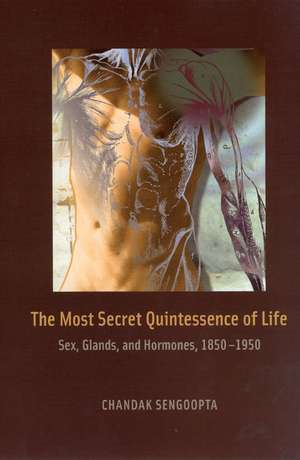The Most Secret Quintessence of Life: Sex, Glands, and Hormones, 1850-1950
Autor Chandak Sengooptaen Limba Engleză Hardback – 29 mai 2006
Less than a century ago, physicians, scientists, and cultural commentators became fascinated by the endocrine glands and the effects of their secretions on our bodies and minds. Of all the characteristics supposed to be governed by them, the attributes of sex evoked the wildest interest. The gonads, it was revealed, secreted chemicals that not only influenced the biological expressions of sex, but seemed to generate the vitality and energy that made life worth living.
Through a series of case studies drawn from Central Europe, the United States, and Britain, The Most Secret Quintessence of Life explores how the notion of sex hormones enabled scientists to remap the human body, encouraging hopes that glandular interventions could cure ills, malfunctions, and even social deviance in ways inconceivable to previous generations. Many of these dreams failed, but their history, Chandak Sengoopta shows, takes us into the very heart of scientific medicine, revealing how even its most arcane concerns are shaped by cultural preoccupations and anxieties.
Through a series of case studies drawn from Central Europe, the United States, and Britain, The Most Secret Quintessence of Life explores how the notion of sex hormones enabled scientists to remap the human body, encouraging hopes that glandular interventions could cure ills, malfunctions, and even social deviance in ways inconceivable to previous generations. Many of these dreams failed, but their history, Chandak Sengoopta shows, takes us into the very heart of scientific medicine, revealing how even its most arcane concerns are shaped by cultural preoccupations and anxieties.
Preț: 474.93 lei
Nou
Puncte Express: 712
Preț estimativ în valută:
90.89€ • 93.89$ • 75.64£
90.89€ • 93.89$ • 75.64£
Carte tipărită la comandă
Livrare economică 25 martie-08 aprilie
Preluare comenzi: 021 569.72.76
Specificații
ISBN-13: 9780226748634
ISBN-10: 0226748634
Pagini: 360
Dimensiuni: 152 x 229 x 33 mm
Greutate: 0.64 kg
Ediția:New.
Editura: University of Chicago Press
Colecția University of Chicago Press
ISBN-10: 0226748634
Pagini: 360
Dimensiuni: 152 x 229 x 33 mm
Greutate: 0.64 kg
Ediția:New.
Editura: University of Chicago Press
Colecția University of Chicago Press
Notă biografică
Chandak Sengoopta is a senior lecturer in the history of medicine and science at Birkbeck College, University of London. He is the author of two previous books, including Otto Weininger: Sex, Science, and Self in Imperial Vienna, also published by the University of Chicago Press.
Cuprins
Acknowledgments
Introduction
1. The Gonads before the Endocrine Era
Introduction
1. The Gonads before the Endocrine Era
2. The Age of the Internal Secretions
3. Sexuality, Aging, and the Gonads: New Physiology and Old Values
4. Ending Gonadal Hegemony: Sex and the Endocrine Orchestra
5. The New Hormones in the Clinic
Epilogue: The Gonads, the Brain, and the Neurohumoral Body
Notes
Index
3. Sexuality, Aging, and the Gonads: New Physiology and Old Values
4. Ending Gonadal Hegemony: Sex and the Endocrine Orchestra
5. The New Hormones in the Clinic
Epilogue: The Gonads, the Brain, and the Neurohumoral Body
Notes
Index
Recenzii
“In his new book Chandak Sengoopta has produced more than an enlightening account of the investigations of scientists and clinicians into the mysterious secretions which appeared to control aging, creativity, youthfulness, and sexuality. The great interest of the study is Sengoopta’s demonstration of the ways in which such inquiries were culturally framed. Whether it is in citing laboratory reports or popular novels, he shows the vast range of intellectual, therapeutic, and cultural purposes to which the glands were turned. In so doing he resurrects the reputations of a number of pioneers whom subsequent generations of scientists ridiculed or consigned to oblivion. This is an engaging work which will be required reading for any student of the history of medicine, but one which will be especially prized by humanists for so brilliantly clarifying the interactions of western science and culture.”--Angus McLaren, author of Twentieth-Century Sexuality: A History
“Chandak Sengoopta has accomplished a remarkable feat: a meticulously researched, carefully argued book that is also accessible and a pleasure to read. The Most Secret Quintessence of Life is essential reading for anyone interested in the development of endocrine research and therapeutics. It also makes a significant contribution to the history of modern notions of sexuality and gender, providing a solid base for future research and analysis.”--Ornella Moscucci, author of The Science of Woman: Gynaecology and Gender in England, 1800–1929
“TheMost Secret Quintessence of Life is an original work filled with rich, new research, relying on important primary literature which has not, until now, been plumbed and digested. In this book, Chandak Sengoopta offers both a history of hormone discovery and a chronicle of how this discovery transformed our concepts of the body and how our existing concepts of sex and sexuality, in turn, informed our concepts for understanding hormones.”--Anne Fausto-Sterling, author of Sexing the Body: Gender Politics and the Construction of Sexuality
"It is easy to write interestingly about sex, harder to be scholarly about this fascinating subject, and hardest of all to be both scholarly and interesting. Chandak Sengoopta has achieved this last feat. The Most Secret Quintessence of Life is a major contribution to the history of sexuality and its medical investigation during the formative period of what is now the thoroughly respectable medical speciality of endocrinology. . . . This fine monograph is cultural history of medicine at its best."
"Examining a century's scientific and popular fascination with endocrine glands and their effects on the body, Sengoopta . . . . concludes that in the end, it was all about sex. . . . This focus on sex allows Sengoopta to follow multiple historical relationships, particularly those between clinicians and basic scientists and between biomedicine and the wide popular culture."
"Sengoopta's superb integration of sources from physiology, gynaecology and literary fiction illustrates how social and scientific temptations shaped endocrinology."
